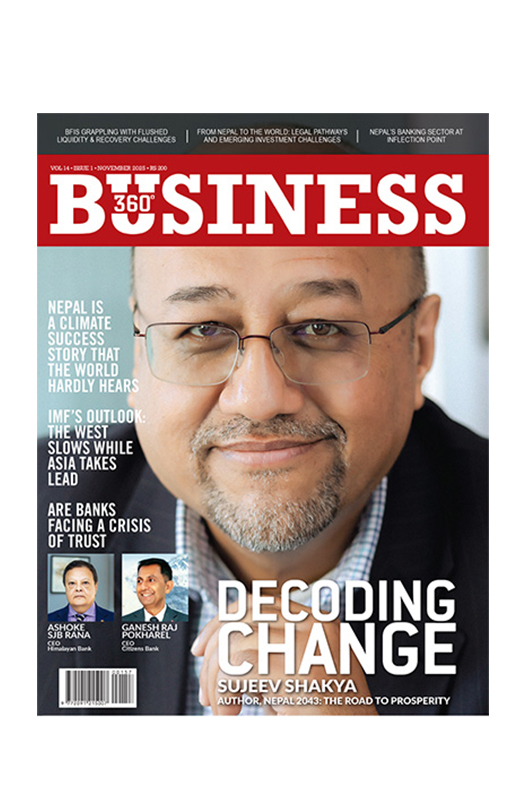-1761806697.jpg)
DENTS TOURISM
Nepal’s tourism sector has taken a serious setback following the Gen Z movement and the ensuing violence and arson with many countries having issued travel advisories. The two-day protests on September 8 and 9 killed 74 people and saw a federal administrative building, Supreme Court and Parliament building torched. For a short period, all three branches of the state (executive, legislature, and parliament) were non-functional.
The Gen Z movement erupted in Nepal to protest against corruption, nepotism, weak governance and a social media ban. The government had banned popular platforms like TikTok and Facebook, demanding they register in Nepal. The protests ultimately led to the ousting of the former government.
During the chaos, the security systems completely failed, and tourists went into panic with some properties being attacked and cancellation of flights. The full extent of the damage is still being assessed but industry leaders report that the hospitality sector has suffered unprecedented losses, even greater than that from the massive earthquake in 2015.
The government is trying to restore normalcy following the recent turmoil, and a general election has been scheduled for March 5, 2026. However, the government has not yet engaged with other countries to get the negative travel advisories lifted.
The protests have occurred at the start of Nepal’s main tourism season (September-November) making a tourism rebound a pressing issue. Nepal’s tourism sector was optimistic about exceeding pre-pandemic levels by 2025, given the strong rebound in 2024. According to Nepal Tourism Board (NTB), a total of 736,562 foreign tourists visited Nepal through August 2025. India was the top source country, followed by the USA and China. Bangladesh and the UK were also in the top five, surpassing visitors from other Asian nations such as Japan, South Korea and Thailand. Meanwhile, tourist numbers from traditional European countries are declining and there has been no significant growth from Australia. (See Table 1)
Nepal’s tourism sector has experienced more than a fair share of ups and downs but always remained resilient. On the verge of collapse during a decade-long insurgency, tourism investment in hospitality significantly increased after the peace accord between the state and the Maoist rebels. According to Deepak Raj Joshi, CEO of Nepal Tourism Board (NTB), the tourism sector is facing unforeseen challenges due to the recent turmoil, despite being on the verge of exceeding its pre-pandemic tourist arrival numbers.
Last year, a total of 1,147,567 (1.14 million) tourists visited Nepal, which was slightly less than the record high of 1.19 million in 2019. Before the main tourism season from September to November, Nepal had already welcomed 736,562 tourists, a significant number that was on track to set a new record for arrivals. (See Chart 1)
-1761812526.jpg)
Private sector investment in Nepal’s tourism infrastructure is massive, matched by significant public sector investment in airports, roads, public facilities and peacekeeping. The public-private partnership approach to branding, marketing, tourist facilitation and destination promotion is also considerable. Nepal’s tourism has a niche market advantage but its potential remains largely untapped.
Binayak Shah, President of Hotel Association Nepal (HAN), stated that peace and the protection of people and property are fundamental for private sector investment, especially in the highly sensitive tourism sector. “Every single negative news story costs this sector,” he said, adding “Peace, stability and the rule of law are fundamental for tourism.” People seek to avoid risks and choose destinations that best meet their expectations.
Despite a massive investment, Nepal’s tourism community has been unable to fully capitalise on its potential. Investors had considered tourism a ‘low-hanging fruit’ due to the country’s gradual economic improvements.
According to the Economic Survey 2024/25, Nepal has 214 five-star and deluxe hotels with 20,343 rooms, as well as 1,364 tourist-standard hotels, lodges and resorts with 42,299 rooms. (See Table 2 and 3)
Several international hotel brands are operating in Nepal and significantly contributing to the tourism sector’s growth. Popular names include Taj, Hilton, Sheraton, Hyatt Centric, Hyatt Regency, Radisson, Moxy, Marriott, Lemon Tree, Fairfield and Royal Tulip. The presence of these international chains not only promotes Nepal as a tourism destination but also helps improve service standards and quality.
The development of the tourism sector has a multiplier effect on jobs and production. Tourism can only thrive in a supportive ecosystem that includes strong infrastructure and services. According to Sagar Pandey, President of Trekking Agencies’ Association of Nepal (TAAN), attention should also be given to strengthening the national flag carrier, ensuring the safety of domestic airlines, providing smooth road access, upgrading trekking trails, and fostering warm hospitality and professional service providers. (See Table 4)
-1761812561.jpg)
Despite massive investment, Nepal’s tourism earnings remain below Rs 100 billion. According to the Ministry of Finance, tourism income grew by 15% in 2024, reaching a total of Rs 83.394 billion, up from Rs 72.46 billion in 2023. However, the average daily spending per tourist slightly decreased to $40.8, with an average stay of 13.3 days. The purposes of visit were 60.4% for recreation and leisure, 15.3% for pilgrimage, 14.5% for mountaineering and adventure, and 9.8% for other purposes.
The return on private sector investment is dependent on the quality of public facilities in the tourism sector. “Tourism products are an integration of public and private facilities, and both stakeholders must work together to harness the potential,” reiterated Joshi, CEO of NTB.
Nepal currently faces challenges in operating its two international airports, the Gautam Buddha International Airport and Pokhara International Airport, as these sophisticated infrastructures are not being fully utilised. Private sector investors in Bhairahawa made massive investments in hotels and hospitality anticipating an influx of tourists after the completion of GBIA but the government’s inability to operate the airport at full capacity has dampened these expectations. Meanwhile, Nepal’s tourism sector is steadily moving forward despite various challenges and immense potential. The recovery challenges persist and the recent turmoil has had a negative impact, at least this season. While there is a light at the end of the tunnel, Nepal is fully equipped to serve more than three million tourists, which is nearly three times the record high from 2019.



-1765706286.jpg)
-1765699753.jpg)

